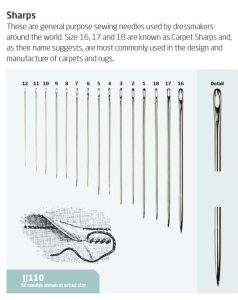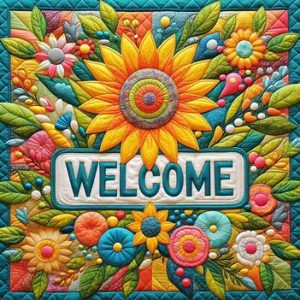

Now for the Pointy End – Let’s Look at Needles
July 5, 2023

Hi!
Today’s post is really a companion to last week’s, when we took a look at the threads we use in sewing and quilting. Today, let’s look at needles for hand sewing or quilting.
Needle Selection
For the Perfect Match when it comes to hand quilting, choosing the right needle can make a world of difference. The size and type of needle you use can affect the ease of stitching, the visibility of your stitches, and the overall result of your quilting project. Here are a few factors to consider:
- Needle Sizes: Needles come in various sizes, denoted by numbers. The most commonly used sizes for hand quilting range from 7 to 12, with smaller numbers indicating larger needles. As a general guideline, thinner threads require smaller needles, while thicker threads need larger needles.


The images above are from John James (https://www.jjneedles.com/needles-guide ), and show the difference between everyday sewing ‘sharps’ and ‘betweens’ for quilting.
- Fine Needles: If you’re working with fine threads like silk or 100% cotton quilting threads, opt for a smaller needle size, such as a size 9 or 10. These fine needles create smaller, more delicate stitches and glide easily through the fabric.
- Medium Needles: For most hand quilting projects using regular cotton or polyester threads, a medium-sized needle like a size 10 or 11 is a good choice. These needles strike a balance between durability and stitch visibility, allowing you to create neat and noticeable stitches.
- Large Needles: When working with thicker threads, such as perle cotton or specialty threads, you’ll need a larger needle to accommodate their size. Some recommend using between a size 5-8 embroidery needle (these are like sharps, but with a longer eye). These larger needles make it easier to pass through multiple layers of fabric and create bold, prominent stitches.

Why Needle Size Matters
The size of the needle impacts both the practicality and aesthetic of your hand quilting. Here’s a few reasons why needle size matters:
- Smooth Stitching: Using the right needle size ensures that the needle and thread work harmoniously together. A needle that is too small for a thick thread may cause the thread to fray or get stuck, making stitching difficult. On the other hand, using a large needle with a fine thread might create overly large holes in the fabric, compromising its integrity.
- Stitch Visibility: The size of the needle affects the visibility of your stitches. A smaller needle creates smaller and less visible stitches, giving a more delicate and refined appearance to your quilting. Conversely, a larger needle produces more pronounced stitches, making them stand out and adding a touch of boldness to your design.
- Fabric Preservation: Selecting the appropriate needle size also helps preserve the fabric’s integrity. Using a needle that is too large for the fabric weight can leave behind noticeable holes or cause damage. By choosing the right needle size, you ensure that the needle penetrates the fabric without causing unnecessary damage or distortion.
Remember, the ideal needle size may vary based on personal preference, thread thickness, and fabric type. There is no rule that says you have to use a specific needle for quilting, or sewing. It’s always a good idea to experiment with different needle sizes to find the one that feels most comfortable and produces the desired results for your specific quilting project.
Other Things to Consider
- Taming Tension: Maintaining consistent tension in your stitches really is the key to achieving a polished look. Aim for a tension that is firm enough to hold the fabric layers together but not so tight that it distorts the fabric. Practice finding that sweet spot by adjusting your grip and experimenting with different levels of pressure. You may like to practice with different needle and thread sizes and weights to find what works best for you.
- Embrace Imperfections: Sewing or quilting by hand really is an art form, and embracing the occasional imperfection adds character to your quilt. Don’t stress over having to have perfectly even stitches, or how many you stitch per inch. Focus instead on the joy of creating – the joy you feel in making something by hand, and remember, it’s that hand-made touch that gives a hand stitched project its uniqueness, and value.
- Practice Makes Progress: Finally, like any skill, hand sewing and quilting requires practice. So, if this is a skill you’d like to master, dedicate some time to practice. Try creating small quilted projects like table runners or bags, or even potholders! You can always practice on scrap fabric too, to build your confidence and improve your technique. Maybe do a variety of different ‘blocks’ and combine them to make your own sampler quilt!
I hope this quick look at needles has given some tips to try when you’re next sewing or quilting by hand.
Enjoy your Week, and Happy quilting!



Leave a Reply